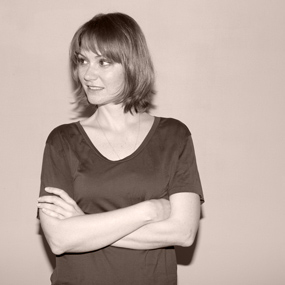Discover the Central Australian outback through Elbowrkshp’s Core Collection
Where It’s At
“Alice Springs is like an island surrounded by oceans of wilderness,” designer Elliat Rich, one half of Elbowrkshp, says about the small town smack in the middle of Australia where she and her partner, James Young, live and work. “It’s a microcosm of our country’s psyche,” she adds, “wrestling with the ongoing process of colonization—and moments of reconciliation—and aiming at a deepening understanding between a rich variety of cultures and very ancient geology.” Calling Alice Springs home means Elliat and James are, some might say, in the middle of nowhere. But this exceptional context fuels their ethically driven design practice in ways that echo the larger, worldwide movement toward design that matters.
Paris-born Elliat and Sydney-born James met and fell in love at Sydney’s College of Fine Arts in 1998. In the early 2000s, they set off on a nearly yearlong camel trek across Australia. Along the way they fell in love with Alice Springs, where they permanently relocated in 2004. Since then, James has been cultivating a high-craft shoemaking atelier, inspired by his family’s century-old trade back in Sydney. Meanwhile Elliat has established herself as one of the country’s rising star designers, working across the discipline, from product design to public art, for a range of clients including indigenous organizations, government agencies, and private companies. In 2014, they launched Elbowrkshp as a retail space and production studio dedicated to projects that, in the designers’ words, “say something about Central Australia” and “increase equality between people and across species.”
A perfect example of the narrative-packed, socially conscious work of Elbowrkshp, Core Collection comprises three simple vessels of sandstone and brass. With their stark geometric form and still-life-like aura, the pieces resonate with the look of many on-trend designs today. But the story behind Core Collection—the design choices that render it a micro-monument to its own birthplace—goes way beyond fashion.
Central Australia is colloquially referred to as the “red centre” because vast swaths of it feature little but ochre-hued sandstone. This geologic phenomenon arose half a billion years ago, when all the earth’s continents were one and much of what would become Australia was under a great inland sea. Iconic to the arid and awesome outback, this sedimentary stone plays an active role in the folklore that defines the area, for better and worse. It also drove the masonry industry in the area from the time of early European settlement until recent decades, when it became cheaper to use imported building materials.
Eager to create something that could only come from Alice Springs, Elliat and James tapped the skills of local tradesmen whose expertise often go unappreciated. “To quarry and cut the ancient bedrock,” Elliat explains, “we worked alongside a second-generation stonemason in his shop, the old shell of an abattoir that burned down under suspicious circumstances in the 1980s. Then we asked core samplers working in the mining industry to put on a craftsmanship hat and drill out each of the concentric pieces. Then a semi-retired turner and fitter with a passion for heavy machinery 'dished out' the small round vessels using a locally fabricated tool. The extensive finishing and detailing was done by James in the Elbowrkshp space.”
Each vessel is unique—made by hand from a natural stone—and each tells the story of its own making. “The project speaks to the landscape here and the area’s meager manufacturing and resource base, which is a very real part of the history of design in Australia,” Elliat says. “Our goal with the Core Collection has been to produce a work that is specific and accurate to our situation, where the end form reflects this place, and we are able to contribute to a dynamic and growing narrative about Central Australia—building something bigger than just ourselves. We want to embrace the local heritage and (literally) drill down on provenance.”
Though quietly working in a remote part of the globe, Elliat receives frequent invitations to share the stories behind her work with national and international audiences. Beyond her aptitude for forms and materials, she is a model for how to use design for good. It’s just who she is. “I was brought up by, if you had to label them, progressive parents,” Elliat says. “All the housework and family management was shared more or less equally. My two brothers and I were brought up with an awareness of inequality and injustice. We marched across bridges for human rights, honked the horn in support of picket lines, and debated the merits of different religions. I remember clearly thinking that design was the perfect way to change the world. In a culture that expresses itself so strongly through materiality, design’s role must be the harnessing of that material language and providing opportunities for change. I have learned that, with and without you, the world changes all the time.”
-
Text by
-
Wava Carpenter
After studying Design History, Wava has worn many hats in support of design culture: teaching design studies, curating exhibitions, overseeing commissions, organizing talks, writing articles—all of which informs her work now as Pamono’s Editor-in-Chief.
-

